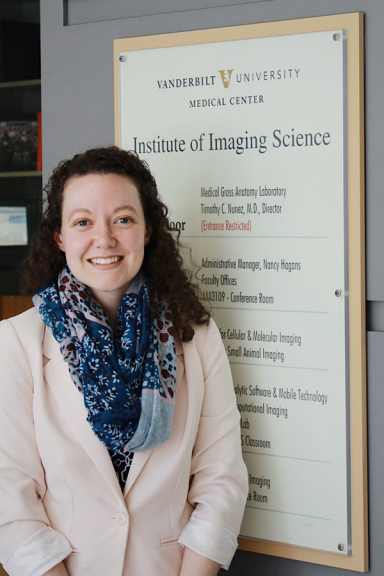Rachelle Crescenzi, Ph.D., Assistant Professor of Radiology, has been awarded the American Heart Association’s Innovation Project Award for her project, “Magnetic Resonance Imaging tools to explore lymphatic clearance of tissue sodium.”
Designed to support new, innovative research that has the potential to result in high-impact discoveries for cardiovascular function, disease and stroke, the Innovation Project Award provides a total of $200,000 in funding over a two-year period.
In collaboration with Joseph Rutkowski, Ph.D., Assistant Professor of Medical Physiology and member of the Division of Lymphatic Biology and the Cardiovascular Research Institute at the Texas A&M College of Medicine, Crescenzi will use a mouse model of inducible lymphatic vessel expansion to study changes in sodium homeostasis in mice with and without expanded lymphatic vessel networks.
“Few technologies are available to study lymphatic circulation in vivo,” says Crescenzi. “Dr. Rutkowski’s animal model is an exciting tool that will allow us to control lymphatic network growth in specific areas using a special diet. This should help us sensitize MRI to lymphatics in these regions, without external contrast agents.”
By pairing lymphatic imaging with sodium MRI technologies in small animals, Crescenzi will first ask whether a more extensive lymphatic vascular network aids salt clearance and increases functional lymphatic transport capacity after high salt diet.
Next, she will translate these technologies to humans with hypertension using high-field 7.0T human MRI in the Vanderbilt University Institute of Imaging Science (VUIIS). Radiology faculty Drs. John Gore, Wellington Pham, and Xinqiang Yan at the VUIIS, will also provide support for this project. She and her collaborators will explore how lymphatic network architecture differs in areas of the body with higher levels of tissue sodium storage in hypertensive compared to normotensive adults.
If relationships between lymphatic architecture and tissue sodium are found through noninvasive MRI methods, this research could open new avenues of investigation into the lymphatic circulatory component of salt handling in hypertension.
Crescenzi’s work in lymphatic diseases began through a postdoctoral fellowship with the Lipedema Foundation, which also supports Rutkowski. “These interdisciplinary collaborations and partnerships with research foundations like the AHA and LF are making a difference in my science and career, and I hope will make a difference for patient communities as well.” said Crescenzi.
Her lab is interested in understanding how lymphatic circulation is involved in regulating tissue sodium, protein and fat metabolism in the body through non-invasive imaging technologies. She is developing novel diagnostic imaging for patients who suffer from lipedema and lymphedema, and exploring hypertension as a possible application of sodium and lymphatic imaging. Her research lab is also supported by an AHA Career Development Award, “Visualizing Vascular Mechanisms of Salt Sensitivity.”
